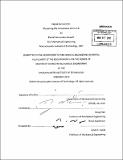Digital ear scanner : measuring the compliance of the ear
Author(s)
Hernandez-Stewart, Daniel
DownloadFull printable version (16.45Mb)
Other Contributors
Massachusetts Institute of Technology. Dept. of Mechanical Engineering.
Advisor
Doug Hart.
Terms of use
Metadata
Show full item recordAbstract
This paper seeks to resolve the biggest problem with hearing aids, their physical fit. By digitally scanning the ear canal and taking the dynamics of the ear into account the performance and comfort of a hearing aid can be greatly improved. Current optical techniques for 3-D imaging are too expensive to be implemented in the ear canal for the purpose of custom fitted hearing aids. A new absorption based optical technique is introduced, which is capable of generating three dimensional maps of an ear subjected to a varying pressure. Specifically a hearing aid can be constructed with allowances for the compliance of the ear and the distortions associated with jaw movement. It is shown that the information that can be captured with this new technique will be of value toward improving hearing aids, and that the hearing aid industry is ready to take advantage of a digital scanner. A one dimensional calibration was made, and qualitative 3-D data is shown. The imaging technique was implemented with much lower cost equipment then would be needed by other 3-D techniques such as interferometry. A technique for the laboratory manufacture of brushed on fluorescent balloons was presented that are suitable to be used by this imaging technique to measure the dynamics of the ear. The bulk compliance of a human ear in vitro was measured with a laboratory fabricated balloon.
Description
Thesis (S.M.)--Massachusetts Institute of Technology, Dept. of Mechanical Engineering, 2010. Cataloged from PDF version of thesis. Includes bibliographical references (p. 101-104).
Date issued
2010Department
Massachusetts Institute of Technology. Department of Mechanical EngineeringPublisher
Massachusetts Institute of Technology
Keywords
Mechanical Engineering.